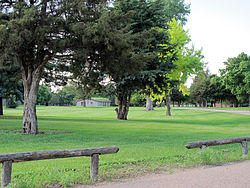Fort Kearny
|
Fort Kearney
|
|

Restored Fort Kearny State Park
|
|
| Nearest city | Newark, Nebraska |
|---|---|
| Coordinates | 40°39′N 99°0′W / 40.650°N 99.000°WCoordinates: 40°39′N 99°0′W / 40.650°N 99.000°W |
| Area | 80 acres (32 ha) |
| Built | 1848 |
| NRHP Reference # | 71000485 |
| Added to NRHP | July 2, 1971 |
Fort Kearny was a historic outpost of the United States Army founded in 1848 in the western U.S. during the middle and late 19th century. The fort was named after Col. and later General Stephen W. Kearny. The outpost was located along the Oregon Trail near Kearney, Nebraska. The town of Kearney took its name from the fort. The "e" was added to Kearny by postmen who consistently misspelled the town name.
The fort became the eastern anchor of the Great Platte River Road and thus an important military and civilian way station for 20 years. Wagon trains moving west, were able to resupply after completing about a sixth (16%) of the journey. The fort offered a safe resting area for the eastern immigrants in this new and hostile land. Livestock could be traded for fresh stock and letters sent back to the States. The fort continued to expand over the years, until there were over 30 buildings before its closure in 1871. It took on additional roles as a Pony Express station, an Overland Stage station and a telegraph station.
The fort was built in response to the growth of overland emigration to Oregon after 1845. The first post, Fort Kearny, was established in the spring of 1848 "near the head of the Grand Island" along the Platte River by Lieutenant Daniel P. Woodbury. It was first called Fort Childs, but in 1848 the post was renamed Fort Kearny in honor of General Stephen Watts Kearny.
Despite its lack of fortifications, Fort Kearny served as way station, sentinel post, supply depot, and message center for 49'ers bound for California and homeseekers traveling to California, Oregon and the Pacific Northwest. The earliest surviving photograph of the post, taken in 1858 by Samuel C. Mills, shows the post as a collection of adobe buildings without any wall or fortifications. By the 1860s the fort had become a significant state and freighting station and home station of the Pony Express. During the Indian Wars of 1864-1865 a small stockade was apparently built upon the earth embankment still visible. Although never under attack, the post did serve as an outfitting depot for several Indian campaigns.
...
Wikipedia


